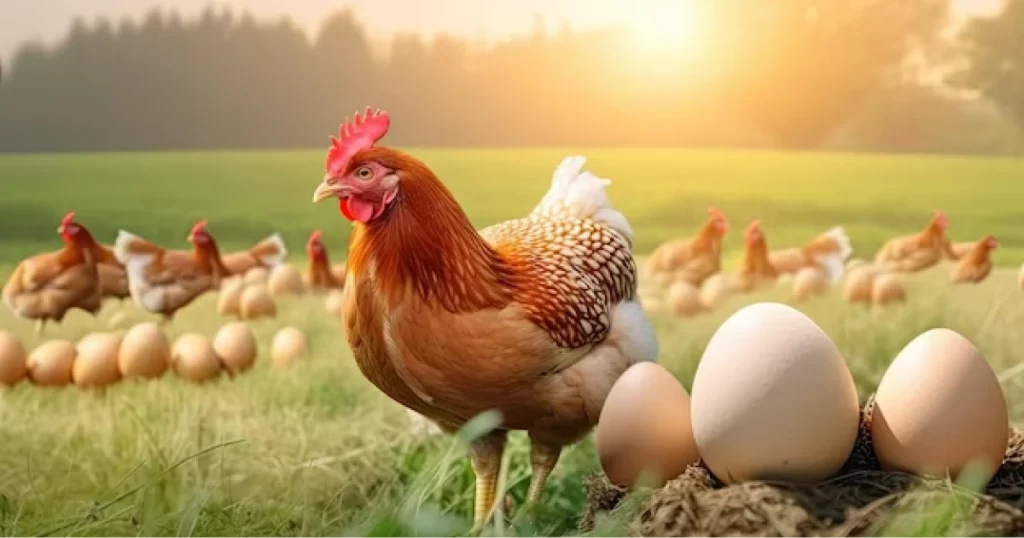Do you know the valuation of poultry farming (meat sector) in India amounted to over Rs.1.44 trillion in FY21? Also, the gross value added from eggs within the livestock sector across India amounted to over Rs.266 billion in FY20.
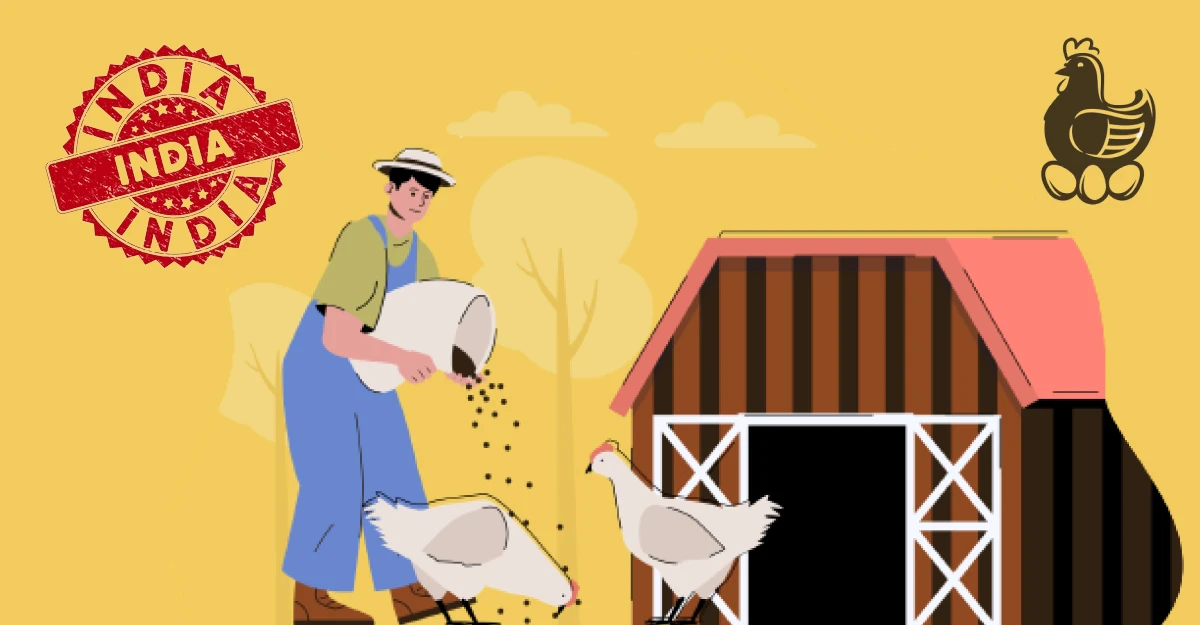
Sounds astonishing! Isn’t it?
Who would have thought that the chicken in your plate is the treasure of fortune for the country…
That’s not all!
India’s poultry farming sector has demonstrated substantial financial success. Really? Well, its a long story.
So without wasting a single second, unveil the feathers of opportunity in this booming industry. In this write-up, we will delve into the market size and the intricate business dynamics that fuel this feathered venture.
Stay tuned!
(A) What is Poultry Farming?
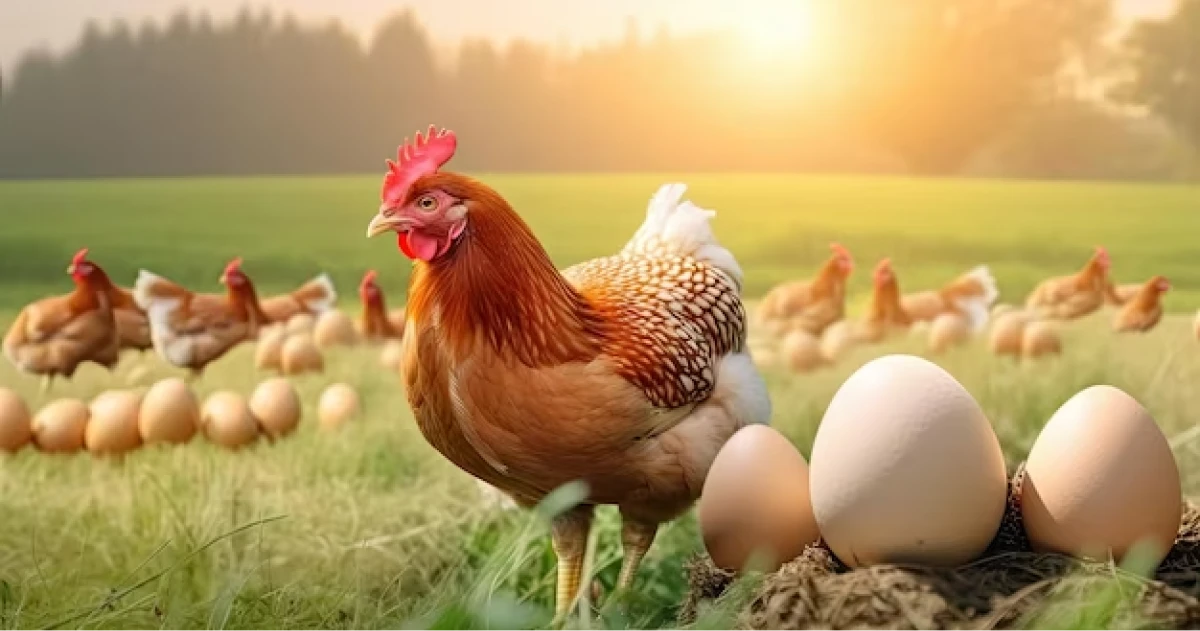
First of all, we will begin with the concept. Poultry farming is defined as the process of raising domestic birds like chickens, turkeys, ducks, geese, and quails for the production of eggs, meat, and feathers.
In India, it is a rapidly growing agribusiness that has transitioned from a non-scientific and unorganized system to a more structured and scientific approach. Here the unorganized system means the backyards!
If you go to villages you will find local breeds of chickens that sound a lot more delicious than the poultry ones! Well, that’s just a public opinion.
Coming back to our discussion. Do you know, our government is also promoting the poultry farms in India?
Yeah! The government’s National Livestock Mission supports and promotes this industry, offering financial assistance to Below Poverty Line (BPL) households to establish poultry farms.
In simple words, poultry farming in India is an integral part of our agriculture, contributing significantly to the supply of protein-rich meat and eggs.
The industry encompasses a range of production methods, from intensive systems in large-scale commercial farms to smaller-scale and free-range operations focusing on animal welfare and sustainability.
Poultry products, readily available in supermarkets and restaurants, cater to the demand for affordable and nutritious protein sources.
Before diving further, let’s briefly look at some FAQs-
Q1. Who is the largest producer of poultry in India?
Answer- Suguna Foods. With a turnover of Rs.10,750, it became the largest broiler producer in India. Do you know, it ranks among the top 10 poultry producing companies in the world? It has maintained its status for the last 35 years.
Q2. Is poultry farming profitable in India?
Answer- Yes! Poultry farming in India is profitable enough to give you a revenue of Rs.10-15 lakhs on an average.
Q3. Which state is best for poultry farming in India?
Answer- Well it changes over time to time. The top states are Tamil Nadu and Maharashtra.
Overall, poultry farming represents a dynamic and evolving sector with economic, nutritional, and agricultural significance. Globally, the poultry industry is crucial for meeting food requirements and is a significant contributor to the economies of many countries.
(B) Famous Cases of Poultry Farming in India
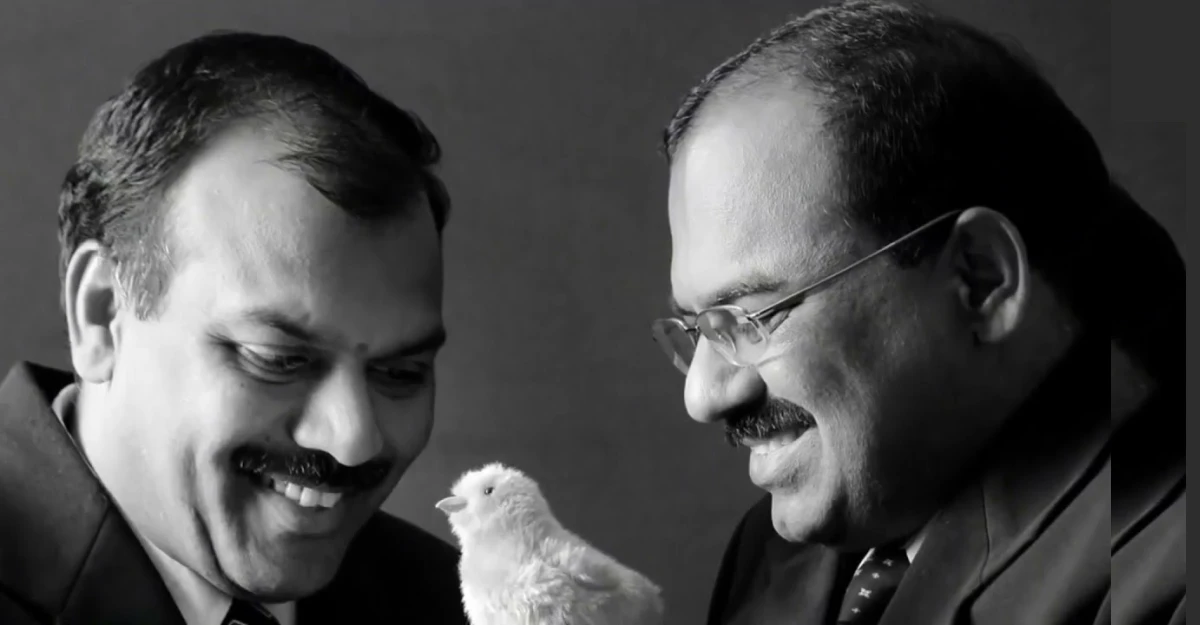
Let me tell you about some of the famous cases of poultry farming in India.
B Sundararajan and GB Sundararajan, two of India’s wealthiest poultry farmers, established their business with a mere Rs 5000 in 1984 and have since achieved a turnover of Rs.12000 crore.
In terms of profitability, it’s noted that a small-scale poultry farm with 500-1000 birds can expect to generate a profit of around Rs. 50,000 to 1,00,000 per year.
The economic contribution of poultry meat in India has also been significant, with gross value added from poultry meat amounting to billions of Indian rupees annually.
Moreover, by starting layer farming at a small level with 1500 chickens, one can earn somewhere between INR 50,000 to 1 lakh.
This demonstrates the substantial net worth potential of poultry farming in India.
(C) Synopsis of Poultry Farming in India
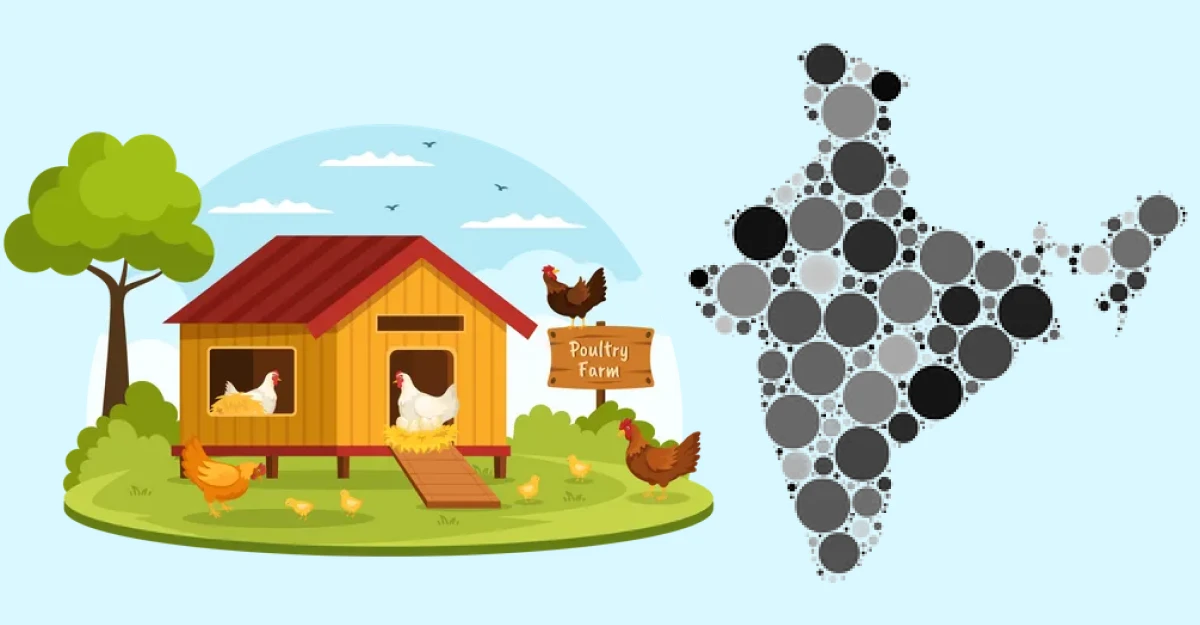
In the diverse tapestry of India’s culinary landscape, the surge in poultry consumption paints a fascinating picture. And what’s the prime reason? Increase in protein intake and income.
Fueled by a potent mix of rapid population growth, evolving dietary preferences, urbanisation, and rising disposable incomes, India stands as one of the global titans in poultry production. The quintessential duo of chicken meat and eggs takes centre stage in this gastronomic revolution.
Chicken meat emerges as the darling of the masses, celebrated for its affordability, adaptability across various cuisines, and widespread accessibility. Meanwhile, eggs, versatile in their own right, play a dual role as a standalone dietary staple and a key ingredient in countless culinary creations. The newfound awareness of the health benefits associated with poultry products acts as a catalyst, propelling their demand to new heights.
The culinary landscape is evolving, with quick-service restaurants (QSRs) expanding and processed convenience foods gaining popularity. This shift further fans the flames of demand for poultry products. Government initiatives, notably the National Livestock Mission, coupled with subsidies and loans supporting poultry farming, play a pivotal role in elevating the sector.
Technological advancements and refined breeding practices contribute to heightened productivity and efficiency in the poultry industry. With a colossal consumer base, escalating demand for protein-rich foods, and unwavering government backing, the Indian poultry market thrives as a dynamic force in the nation’s culinary and economic narrative.
(D) Poultry farming in India: Market Overview
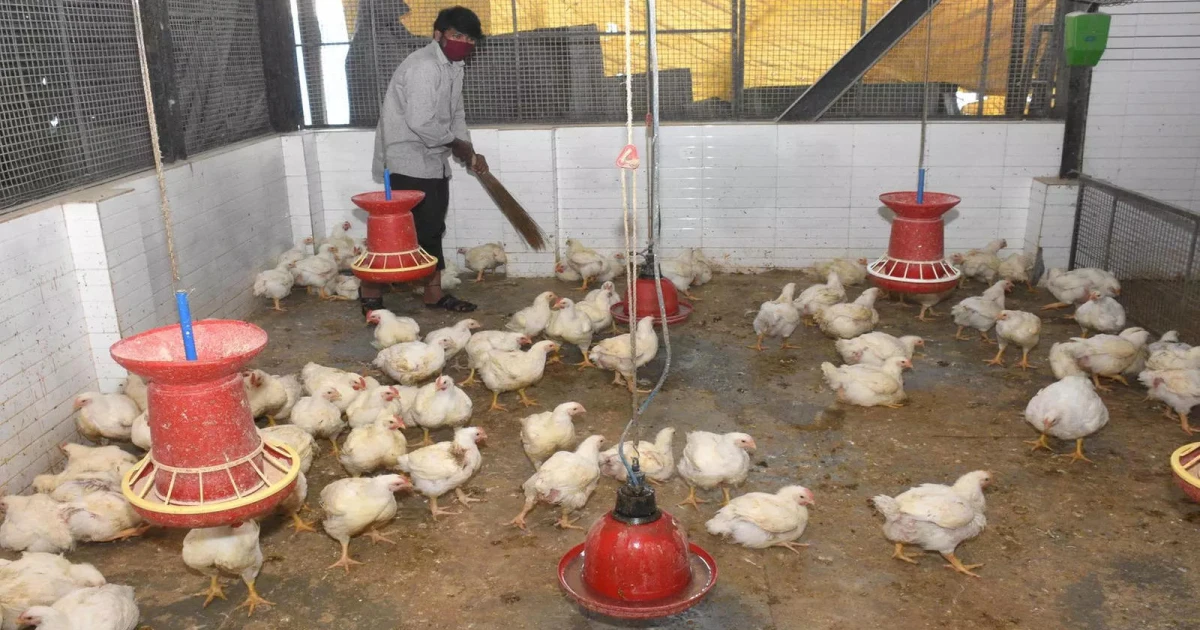
In 2022, the poultry market in India achieved a substantial size, reaching INR 1,905.3 Billion. This comprehensive market analysis is conducted primarily by the IMARC Group, renowned as the International Market Analysis Research and Consulting Group. As a global leader in management strategy and market research, IMARC Group provides key insights into market trends and dynamics.
Looking ahead, IMARC Group anticipates a notable growth trajectory, projecting the market to soar to INR 3,477.8 Billion by 2028. This represents a Compound Annual Growth Rate (CAGR) of 10.18% during the period from 2023 to 2028. The factors propelling this growth include a burgeoning population, heightened demand for poultry products, evolving consumer dietary preferences, increased disposable incomes, and the rapid expansion of the food service sector.
Poultry farming, encompassing the raising of birds like ducks, turkeys, chickens, and geese for eggs and meat, has witnessed substantial evolution over the decades. Today, it stands as a crucial sector within the Indian economy.
The forecasted period also anticipates a boost in the poultry market through the growing popularity of online food delivery platforms such as Zomato and Uber Eats. This surge in the food services market is expected to contribute to the overall growth of the poultry industry in India.
Examining end-uses, households emerge as the primary segment for eggs, while food services take the lead for broilers. This is attributed to increased egg consumption during home breakfasts and a growing trend of dining out, respectively. In the subsequent sections, we will delve into the specific details of these trends and their implications for the Indian poultry market.
Note: When it comes to indigenous industries, we can never forget the brand “Dabur.” This century old brand has a rich history with massive focus on innovation and marketing. For detailed information, visit the article “Success story of Dabur.”
(E) Market Trends of Poultry Farming in India
Let’s look at some of the popular trends in our poultry industry-
(E.1) Evolving Consumer Preferences & Increased Demand
India’s burgeoning population contributes to a rising demand for poultry products, driven by an expanding middle class and increasing disposable incomes. The financial capabilities of a larger segment of the population enable them to incorporate poultry into their diets.
Shifting dietary preferences, influenced by busy lifestyles, result in a higher demand for convenient and protein-rich foods. Chicken, known for its versatility, affordability, and widespread availability, emerges as a preferred protein source.
Growing awareness of the nutritional benefits associated with poultry consumption, coupled with an increased understanding of the importance of a balanced diet, fuels the demand for poultry products.
(E.2) Technological advancements reshaping Poultry farming in India
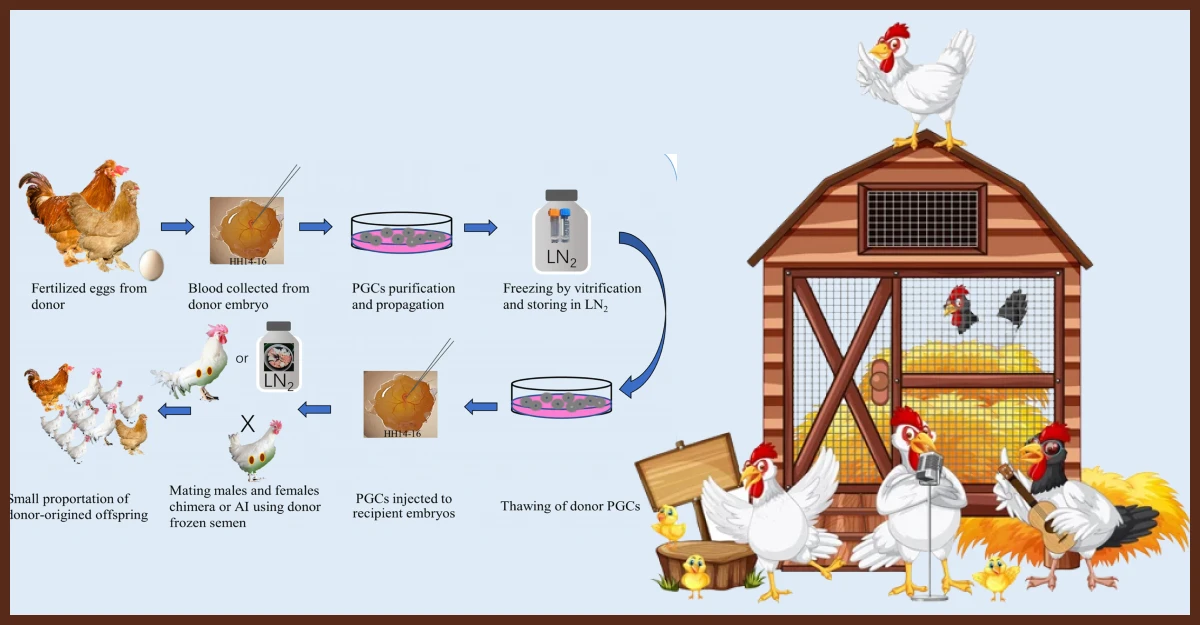
A notable trend in the Indian poultry industry is the increasing adoption of technology and automation, transforming traditional poultry farming practices. Poultry farms are integrating advanced farm management systems that leverage technology to streamline various operations.
Automated feeding, climate control, and data monitoring tools are becoming integral to efficient farm management. Technology is also playing a crucial role in disease prevention and control.
Systems equipped with sensors and cameras continuously monitor bird behavior, feed intake, water consumption, and other vital signs. This allows for the early detection of abnormal patterns, enabling prompt intervention and preventing the spread of diseases.
Furthermore, automation in egg collection and processing reduces labor requirements and enhances overall efficiency. The rise in popularity of precision farming techniques further supports the overall growth of the poultry market in India.
(F) Indian Poultry Industry Segmentation
The India poultry market report by IMARC Group analyzes key trends in each segment, providing forecasts at the country and state level from 2023-2028. The market segmentation is based on end use, distribution channel, and states.
| Criteria | Segmentation |
| End Use | Food Services |
| Households | |
| Distribution Channel | Traditional Retail Stores |
| Business to Business (B2B) | |
| Modern Retail Stores | |
| States | Maharashtra, Haryana, West Bengal, Tamil Nadu, Andhra Pradesh, Uttar Pradesh, Telangana, Kerala, Karnataka, Punjab, Orissa, Bihar, Madhya Pradesh, Gujarat, Rajasthan, Others |
(F.1) By End Use
- Food Services
- Households
The report offers a detailed breakdown and analysis of the market concerning end use, focusing on food services and households. According to the findings, food services represent the largest segment.
The food service sector, comprising restaurants, cafes, hotels, and quick-service outlets, plays a pivotal role.
As urbanization increases and lifestyles become more fast-paced, reliance on food services grows. Poultry products, especially chicken, are favored for their affordability, versatility, and quick cooking time, making them staples in the menus of establishments.
The organized food service sector has witnessed substantial growth, driven by changing social dynamics, rising disposable incomes, and a growing desire for experiential dining. Poultry-based dishes, including chicken curries, tandoori chicken, biryanis, and sandwiches, feature prominently.
The proliferation of online food delivery platforms, urbanization, and evolving lifestyles further contribute to the growth of this segment.
(F.2) Distribution Channel
- Traditional Retail Stores
- Business to Business (B2B)
- Modern Retail Stores
The report includes a comprehensive analysis of the market based on the distribution channel, covering traditional retail stores, business to business (B2B), and modern retail stores.
Traditional retail stores emerge as the largest market share holder. Traditional retail stores, such as local grocery stores and supermarkets, align with cultural preferences, allowing consumers to inspect and choose fresh poultry products. They play a crucial role in supporting local economies and fostering community connections.
These stores, well-versed in local culinary traditions, offer a personalized shopping experience, with a range of poultry cuts catering to specific regional dishes
(F.3) By Indian States
- Maharashtra,
- Haryana,
- West Bengal,
- Tamil Nadu,
- Andhra Pradesh,
- Uttar Pradesh,
- Telangana,
- Kerala,
- Karnataka,
- Punjab,
- Orissa,
- Bihar,
- Madhya Pradesh,
- Gujarat,
- Rajasthan,
- Others
Maharashtra commands the largest market share, attributed to its well-established modern retail infrastructure, comprising supermarkets, hypermarkets, and specialty stores.
Major cities in the region boast large retail chains and shopping malls that offer a diverse array of food products, including poultry, creating a one-stop shopping experience. The prevalence of modern retail outlets ensures convenient access to poultry products for urban consumers, boosting sales volume.
Furthermore, Maharashtra is renowned for its vibrant food service industry, encompassing a variety of restaurants, hotels, cafes, and street food vendors. The state’s culinary landscape spans local Maharashtrian, North Indian, South Indian, Chinese, and international flavors, with poultry, particularly chicken, playing a pivotal role in many dishes.
It stands as a key component on the menus of Maharashtra’s food service establishments.
Another contributing factor is Maharashtra’s robust economic growth and the increased disposable incomes of its residents, facilitating higher spending on food, including poultry products.
As one of the most urbanized states in India, Maharashtra exhibits a high population density. Urban centers like Mumbai, Pune, Nagpur, and Nashik boast substantial consumer bases with diverse culinary preferences, resulting in a heightened demand for poultry products.
The concentration of urban centers and a large population collectively drive the strong market growth for poultry products in the state.
(G) Competitive Landscape of Poultry Farming in India
Now, let’s look at the competition in the poultry industry of India-
(G.1) Market Growth & Key Player Strategies
The poultry market is on a trajectory of steady growth, propelled by strategic initiatives undertaken by key players to fortify their market positions, cater to evolving consumer demands, and leverage emerging opportunities.
Established players are notably expanding production capacities and diversifying product portfolios to address a broader range of consumer preferences. The introduction of new product variants, including value-added and processed poultry products, is a strategic move aimed at capturing a larger market share and adapting to changing consumer needs.
(G.2) Vertical Integration Strategies & Technological Investments
Many large-scale poultry companies are embracing vertical integration strategies, streamlining operations, improving traceability, and enhancing overall business performance. The infusion of substantial investments into technology and automation is a common trend among key players. This strategic move is geared towards enhancing efficiency, productivity, and animal welfare within the poultry industry.
(G.3) Emphasis on Sustainability and Responsible Practices
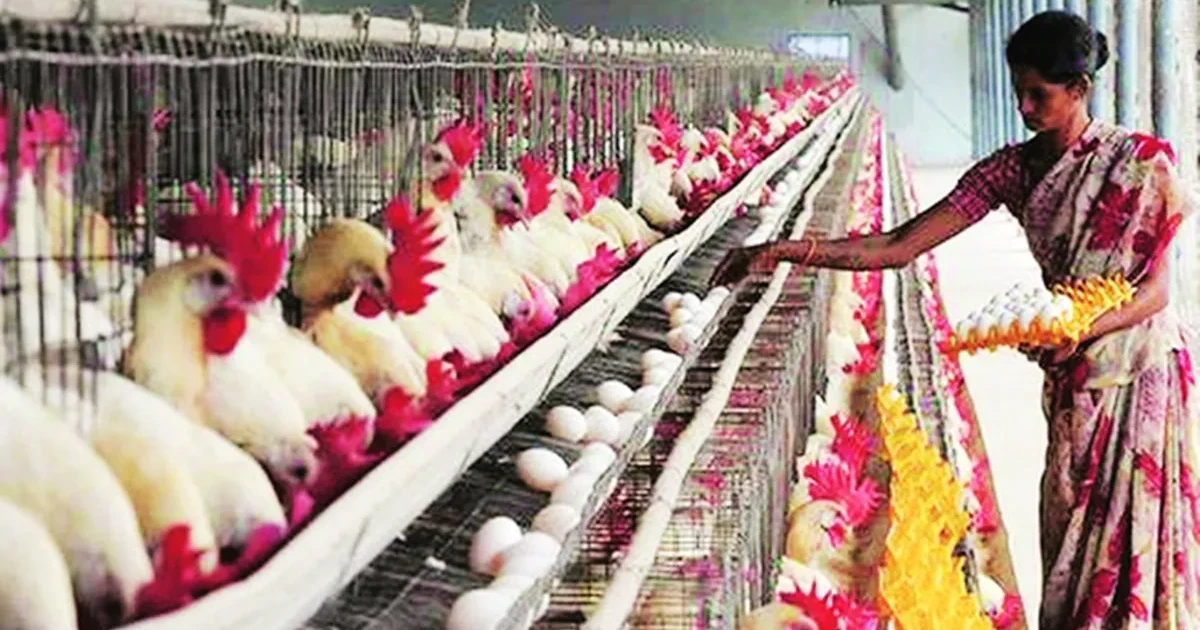
The market is witnessing a notable surge in the adoption of sustainability and responsible practices. Key players are placing a heightened emphasis on efficient waste management, aligning with growing environmental concerns. Simultaneously, investments in marketing and brand-building activities are underway to bolster market presence.
(G.4) Collaborations and Partnerships for Healthy Competition
To foster healthy competition within the domain, key players are increasingly engaging in collaborations and partnerships. These strategic alliances extend to retailers, food service providers, and e-commerce platforms, further diversifying distribution channels and enhancing market reach.
(G.5) Comprehensive Analysis in the Report
The report provides a comprehensive analysis of the competitive landscape within the poultry market. Detailed profiles of major companies are included, offering insights into their strategies, operations, and market presence. Some of the featured companies encompass-
- Bharati Poultry Pvt. Limited
- IB Group
- Mulpuri Group
- RM Group
- Simran Farms Limited
- Skylark Hatcheries Pvt. Ltd.
- Sneha Group Srinivasa Farms Private Limited
- Suguna Foods Private Limited
- VH Group
(H) Indian Poultry Sector: A Catalyst for Agricultural Prosperity
Let’s look at the overall scenario of poultry farming in India-
(H.1) Overview of the Allied Sectors
The Indian agricultural landscape is witnessing a transformative shift with the livestock, poultry, and aquaculture sectors emerging as key contributors to buoyant growth and enhanced farm incomes. According to the Economic Survey (2022-23), the livestock sector, encompassing dairy, poultry meat, eggs, and fisheries, has exhibited a remarkable Compound Annual Growth Rate (CAGR) of 7.9% from 2014-15 to 2020-21. Its contribution to the total agriculture Gross Value Added (GVA) has escalated from 24.3% in 2014-15 to 30.1% in 2020-21.
(H.2) Growth Drivers of the Poultry Industry
India’s poultry industry is experiencing robust growth fueled by increasing disposable incomes and shifts in dietary preferences. The transition from traditional pulse-based diets to animal-origin protein sources, including meat, eggs, and dairy products, is a pivotal factor driving industry expansion. Heightened awareness of health and wellness is further propelling the demand for protein-rich diets. The proliferation of distribution channels, coupled with the growth of the food services market, is providing a significant impetus to the poultry sector.
(H.3) Current State of Poultry Production
The country’s egg production has surged to 126.53 billion in 2021-22, demonstrating a consistent growth rate of 5% per annum. Notably, poultry product exports have surged nearly 100%, reaching USD 137 million in 2022-23 from USD 71 million in the previous fiscal year, according to data from the Agricultural and Processed Food Products Development Authority (APEDA).
(H.4) Socio Economic Impact of Livestock and Poultry
India’s vast resources in livestock and poultry play a pivotal role in improving the socio-economic conditions of rural communities. The 20th Livestock Census, 2019, indicates a 17% increase in the poultry bird population, reaching 851.81 million, contributing significantly to economic upliftment.
(H.5) Market Valuations & Projections
According to a report by Expert Market Research (EMR), the Indian poultry market is valued at USD 28.18 billion in 2022. Anticipating a Compound Annual Growth Rate (CAGR) of 8.1% during 2023-2028, the market is projected to reach USD 44.97 billion by 2028. The share of commercial broiler birds in total meat production accounts for approximately 80-85%, with the remaining 15-20% contributed by backyard poultry, notably from northeastern states.
(H.6) Government Initiatives and Financial Incentives
The government has implemented several programs to encourage poultry farming, particularly aimed at empowering rural youth. Various state government schemes provide financial assistance for establishing poultry farms. Notably, the Asian Development Bank has extended a USD 10 million loan to leading poultry integrators under the Sustaining Poultry Farmer Income and Food Security Project in India.
(H.7) Feed Challenges and Agricultural Policies
Ensuring a consistent supply of quality feed ingredients, particularly maize (corn) and soya meal, is crucial to prevent volatility in feed prices. Feed costs constitute approximately 60–65% of the total production cost of poultry broilers. India aims to increase maize production by 10 million tonnes over the next five years, addressing demand from the ethanol production sector and the poultry industry.
A key challenge lies in stagnant soybean production in recent years. Initiatives to promote maize production and stable soybean supply, along with measures like importing genetically modified soybean meal during supply constraints, contribute to maintaining feed price stability.
(H.8) Role of Cold-Chain Infrastructure
The future trajectory of the poultry industry involves transitioning from live bird markets to sophisticated, ISO-certified facilities and ready-to-eat convenience products. The absence of adequate refrigeration infrastructure poses a significant hurdle. Special government schemes, akin to the ‘Integrated Cold Chain and Value Addition Infrastructure,’ are needed to promote the creation of more cold chains in the poultry sector.
The shift in demand from live birds to fresh, chilled, and frozen poultry products is evident, with the burgeoning growth of e-commerce and home delivery models. Additional financial incentives for modern transportation vehicles and cold storage infrastructure are imperative to further elevate the poultry sector.
(I) The Future Outlook of the Domestic Poultry Industry in 2023-24
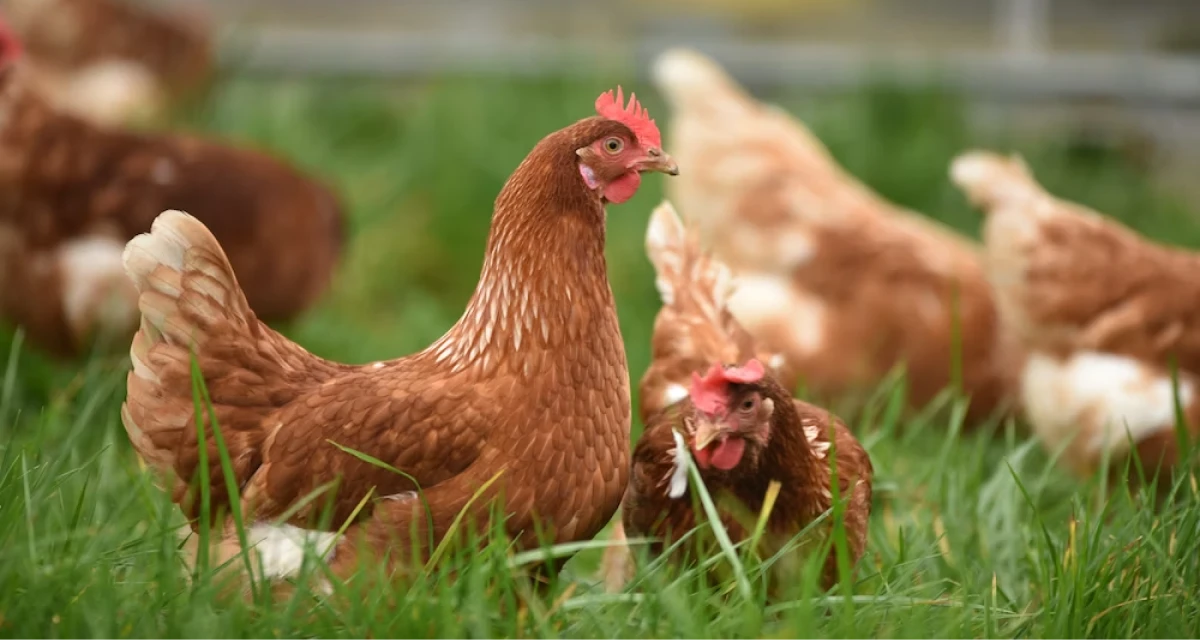
The domestic poultry industry is poised for substantial growth, projected to reach 8-10% in the fiscal year 2023-24. This optimistic forecast is underpinned by increased volumes, robust realizations, stable demand, and a notable uptick in the penetration of processed chicken and value-added products, as revealed in a recent report.
However, the industry’s earnings are expected to encounter volatility, primarily due to fluctuations in raw material prices, especially maize. Players in the sector may face challenges in fully passing on the increased costs to consumers.
(I.1) Revenue Growth and Contributing Factors
ICRA, in its comprehensive report, anticipates a steady pace of revenue growth for the domestic poultry industry, driven by both volume and realization factors. The consistent growth in volumes and the increased acceptance of processed chicken and value-added products are key contributors to the positive revenue outlook. Stable demand further reinforces the industry’s potential for sustainable growth.
(I.2) Raw Material Price Dynamics
The report sheds light on the significant surge in maize prices, escalating by 32% on an annual basis in the initial nine months of FY23. This upswing is attributed to the heightened global demand for Indian maize following the Russia-Ukraine conflict, resulting in an overall increase in average feed prices. While soybean prices had earlier posed pressure on feed costs, the current fiscal year reflects a moderation in these costs.
(I.3) Forward Integration Strategies
In response to the challenges posed by raw material price fluctuations, Icra foresees a strategic move by poultry companies towards forward integration in the medium term. This entails investments in setting up processing plants, facilitating a shift towards higher-margin value-added products. This strategic shift aligns with the industry’s quest for enhanced profitability and resilience against external uncertainties.
(I.4) Challenges and Vulnerabilities
The report underscores the potential vulnerability of the Indian chicken business due to recent global bird flu outbreaks. Despite only a few isolated instances in India, a widespread outbreak could negatively impact demand, leading to significantly lower realizations. This highlights the industry’s susceptibility to external factors, necessitating proactive measures and contingency planning.
(J) Wrapping up: Poultry Farming in India
Poultry farming stands as a rapidly growing sector within Indian agriculture, serving as a vital source of protein for the nation’s population. The industry plays a crucial role in supporting numerous small-scale farmers, and during the pandemic, organizations like the Asian Development Bank stepped in to assist tens of thousands of poultry farmers, ensuring business continuity.
Establishing a poultry farm in India is perceived as a lucrative agribusiness, driven by the high demand for poultry products. While the industry’s profitability is evident, concerns about its sustainability have prompted calls to reconsider support for animal agriculture in India.
Small-scale poultry farms, operating with 500-1000 birds, can anticipate generating profits ranging from Rs.50,000 to 1,00,000 per year, making it a potentially rewarding venture in the agricultural landscape.
As the industry navigates opportunities and challenges, strategic adaptations and sustainability considerations will play pivotal roles in shaping its future trajectory.

